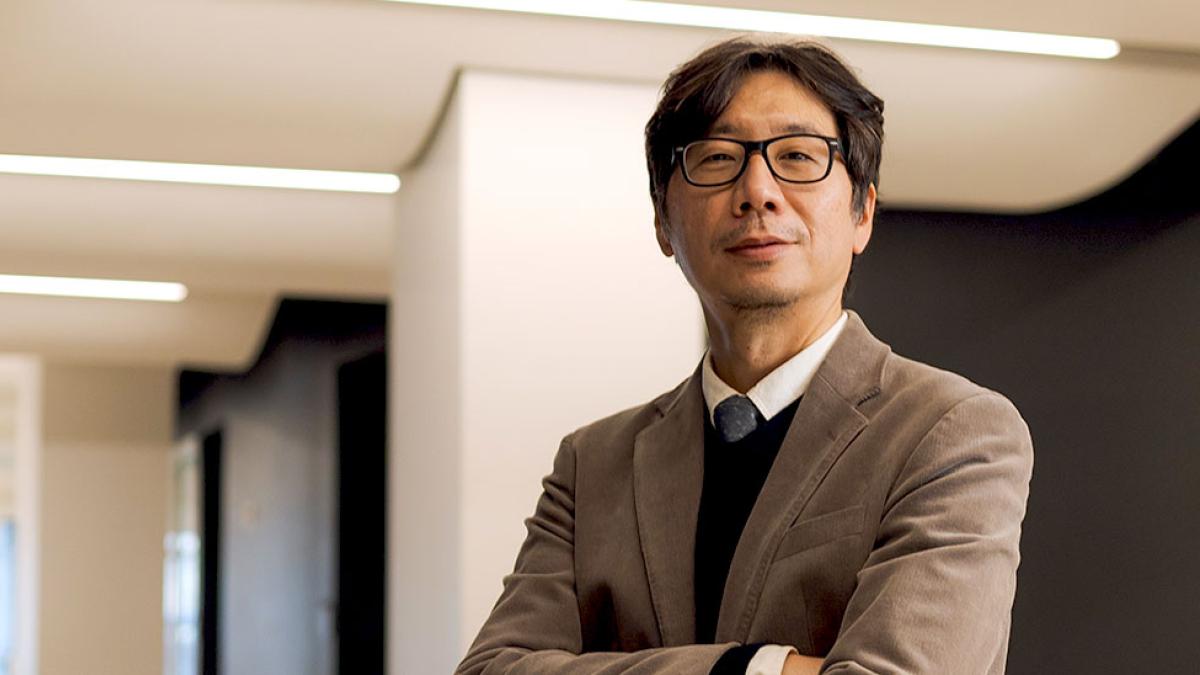What Jobs Can You Get With a Computer Science Degree?
Explore top CS jobs, career outlook, and salaries. Learn what you can do with a computer science degree and how Pace University prepares you for success.


With a computer science degree, you can pursue a variety of high-demand careers across industries, from cybersecurity and healthcare to finance, government, and beyond. This degree opens the door to roles focused on innovation, data, and infrastructure that are central to the modern economy.
According to the U.S. Bureau of Labor Statistics, about 356,700 job openings in computer and information technology occupations are projected each year through 2033. Many roles are growing much faster than average—for example, jobs for information security analysts are expected to grow by 33% in the same timeframe. A computer science degree prepares students to meet this demand through a mix of technical expertise and career-building experience.
What is a Computer Science Major?
A major in computer science provides the tools that enable you to build the systems behind today's tech-powered world. As a computer science student, you’ll study programming languages, data structures, algorithms, and operating systems—the building blocks of software and digital systems. Along the way, you’ll gain hands-on experience solving real-world problems and explore emerging fields including cybersecurity, artificial intelligence, and cloud computing. It’s a degree for curious thinkers who want to understand how technology works and shape what it does next.
At Pace University, students pursuing a Bachelor of Science (BS) in Computer Science develop skills grounded in rigorous coursework and enhanced by experiential learning. Students work on real-world projects, collaborate with expert faculty, and explore high-impact areas such as AI, mobile app development, game programming, and cybersecurity. You'll also have access to advanced facilities including Pace’s Cyber Range and Artificial Intelligence Lab, and have the option to participate in global collaborations through the NYC Design Factory.
The BS program is STEM-designated and accredited by ABET, signaling both academic excellence and strong job-market preparation. Graduates enter roles such as software engineer, security analyst, cloud architect, or data scientist, with many earning starting salaries above $90,000 and landing jobs at top companies such as Google, Amazon, IBM, JPMorgan Chase, and Microsoft.
Students interested in advanced study can continue on to earn a Master of Science (MS) in Computer Science, or in areas including artificial intelligence or software engineering, or pursue a PhD in Computer Science focused on original research and innovation leadership.
Whether you’re building your first app or designing the next breakthrough in machine learning, a computer science degree from Pace positions you at the leading edge of technology and opportunity.
What do you learn as a Computer Science major?
A computer science degree teaches both the technical and professional skills needed to succeed in a wide range of industries. Students learn core concepts in data structures, algorithms, computer architecture, and programming languages—then explore key technologies such as cybersecurity, artificial intelligence, machine learning, and game development.
At Pace, CS majors also gain experience in software development, user interface design, and mobile/web application creation. Alongside technical training, students build the soft skills critical for career growth, including teamwork, project management, and written and verbal communication. These skills help graduates collaborate effectively and lead projects in real-world settings.
Computer Science Demand and Job Outlook
The demand for skilled computer science professionals remains strong. Multiple career paths within the field are projected to experience double-digit growth over the next decade, driven by the increasing need for secure systems, intelligent software, and data-driven solutions.
Several individual career paths within computer science are among the fastest-growing nationwide:
- Information security analysts: projected 33% growth
- Software developers: projected 17% growth
- Database administrators and architects: projected 9% growth
- Computer and Information Research Scientists: projected 26% growth
These trends reflect the expanding role of computer science across all areas of the modern economy and signal a promising job market for future graduates.
Careers in Computer Science
Computer science is one of the most adaptable and opportunity-rich degrees available today. At its core, this major prepares students to think logically, code efficiently, and solve problems with technology. But its reach extends well beyond the tech industry. CS graduates find roles in business, healthcare, government, nonprofits, finance, and start-ups—essentially anywhere innovation depends on digital tools.
Students can explore a range of specializations to match their interests and career goals. Some common career paths and focus areas include:
|
|
What Jobs Can You get With a Computer Science Degree?
Whether you're developing new software or safeguarding sensitive data, a computer science degree equips you for a broad spectrum of roles. Below are common job titles for CS majors, including new additions to align with current job market trends:
| Job Title | Responsibilities | Annual New York City Metro Salary (USD)* |
|---|---|---|
| Software Developer | Designs, builds, and maintains software applications and systems | $154,095 |
| Information Security Analyst | Protects networks and systems from cyber threats through monitoring and mitigation | $82,392 |
| Data Scientist | Analyzes complex data to guide business decisions and uncover insights | $85,600 |
| UX Designer | Designs user-friendly interfaces for websites, apps, and software | $136,733 |
| Database Administrator | Manages and secures large-scale databases for performance and accessibility | $119,334 |
| Network Architect | Designs and implements data communication networks such as intranets and LANs | $132,485 |
| Systems Administrator | Oversees daily operations and maintenance of computer systems and servers | $84,287 |
| AI/ML Engineer | Develops intelligent systems that learn and adapt using algorithms and data models | $126,202 |
| IT Project Manager | Leads technical projects, managing timelines, teams, and resources | $164,733 |
| Web Developer | Builds and maintains responsive websites and web-based applications | $109,537 |
*Salary figures are as of May 2025 from salary.com. Wages may fluctuate in real-time as more salaries are submitted. Salaries can vary based on company, years of experience, and other factors.
Companies Hiring Computer Science Graduates
Computer science graduates are in high demand across nearly every industry. In the New York metro area, top employers include global tech firms, financial institutions, media companies, healthcare systems, and government agencies.
While exact job openings change frequently, examples of companies actively seeking CS talent include:
- JPMorgan Chase & Co. – software engineering and data analytics roles
- Google NYC – software development, UX design, and AI research positions
- Mount Sinai Health System – roles in cybersecurity, IT support, and data management
- Verizon – opportunities in cloud infrastructure, network security, and mobile tech
- NYC Department of Information Technology & Telecommunications (DoITT) – public sector roles in systems administration, database design, and application development
- IBM – AI, quantum computing, and software development roles in Westchester and beyond
Smaller start-ups and tech consultancies throughout New York also offer exciting roles for recent graduates. Whether your goal is to work for a Fortune 500 company or an early-stage innovator, computer science opens doors across the region.
Majoring in Computer Science at Pace University
At Pace University, computer science majors benefit from hands-on learning, industry-aligned curriculum, and the resources of the Seidenberg School of Computer Science and Information Systems. Students can choose between a Bachelor of Arts (BA) and a Bachelor of Science in Computer Science—both STEM-designated and career-focused.
The BA in Computer Science offers flexibility for students interested in pairing computer science with another discipline, such as digital design, economics, or cybersecurity. It’s ideal for students pursuing careers in product design, IT consulting, or tech policy.
The BS in Computer Science, accredited by the Computing Accreditation Commission of ABET, provides a more rigorous and technical foundation. Students dive into areas such as software engineering, databases, and systems architecture, gaining the skills needed for high-demand careers in software development, information security, and AI.
All programs emphasize applied learning through capstone projects, research opportunities, and professional partnerships. Whether you study at our New York City or Westchester campus, you’ll graduate with the skills—and connections—to thrive in the tech world.
Computer Science Internships in New York City
Pace University students gain direct access to internship opportunities across both campus locations. In New York City, students benefit from proximity to global tech hubs, start-ups, and Fortune 500 companies. The Seidenberg School regularly connects students with employers offering roles in software development, cybersecurity, and data science.
At Pleasantville, our Westchester campus offers a residential college experience just 45 minutes from Manhattan. Students can intern locally with regional tech firms or commute into the city using the Metro-North rail system.
Explore our New York City Campus and Westchester Campus pages to learn more about how each location supports your career goals.
Frequently Asked Questions
What can you do with a computer science degree?
A computer science degree opens the door to careers in software development, cybersecurity, data science, artificial intelligence, and more. Graduates work across industries such as finance, healthcare, government, and tech.
Do computer science jobs pay well?
Yes. Most computer science careers offer competitive salaries. In the New York City metro area, roles including software developer, data scientist, and security analyst regularly earn six-figure salaries.
Is computer science a good major?
Absolutely. Computer science is one of the most versatile and in-demand majors. It prepares students for a wide range of high-growth careers and fosters problem-solving skills that are valuable in any field.
What are the career opportunities for computer science majors?
Career paths include software engineer, AI/machine learning engineer, cybersecurity analyst, web developer, systems architect, and more. Many roles are accessible with a bachelor’s degree, while others benefit from graduate study.
Learn more about what you can do with a Computer Science Degree
At Pace University, our Computer Science Bachelor’s degrees prepare you to do many technology-related jobs in software development, information security, and computing. Whether you join us in Westchester or NYC, our program provides a career-ready undergraduate education that translates your goals into a successful computer science career. For students looking to continue their education, Pace offers a range of in-person or online master's degree programs, including an online Master of Science in Computer Science degree.
Explore the BS, MS, and PhD in Computer Science at Pace—or request more information to get started.
Press Release: Pace University Unveils Center for Leadership & Emotional Intelligence
Emotional intelligence and teamwork are non-negotiable skills for effective leadership and success, according to an executive who runs a global company focusing on marketing, communications, and creative services.
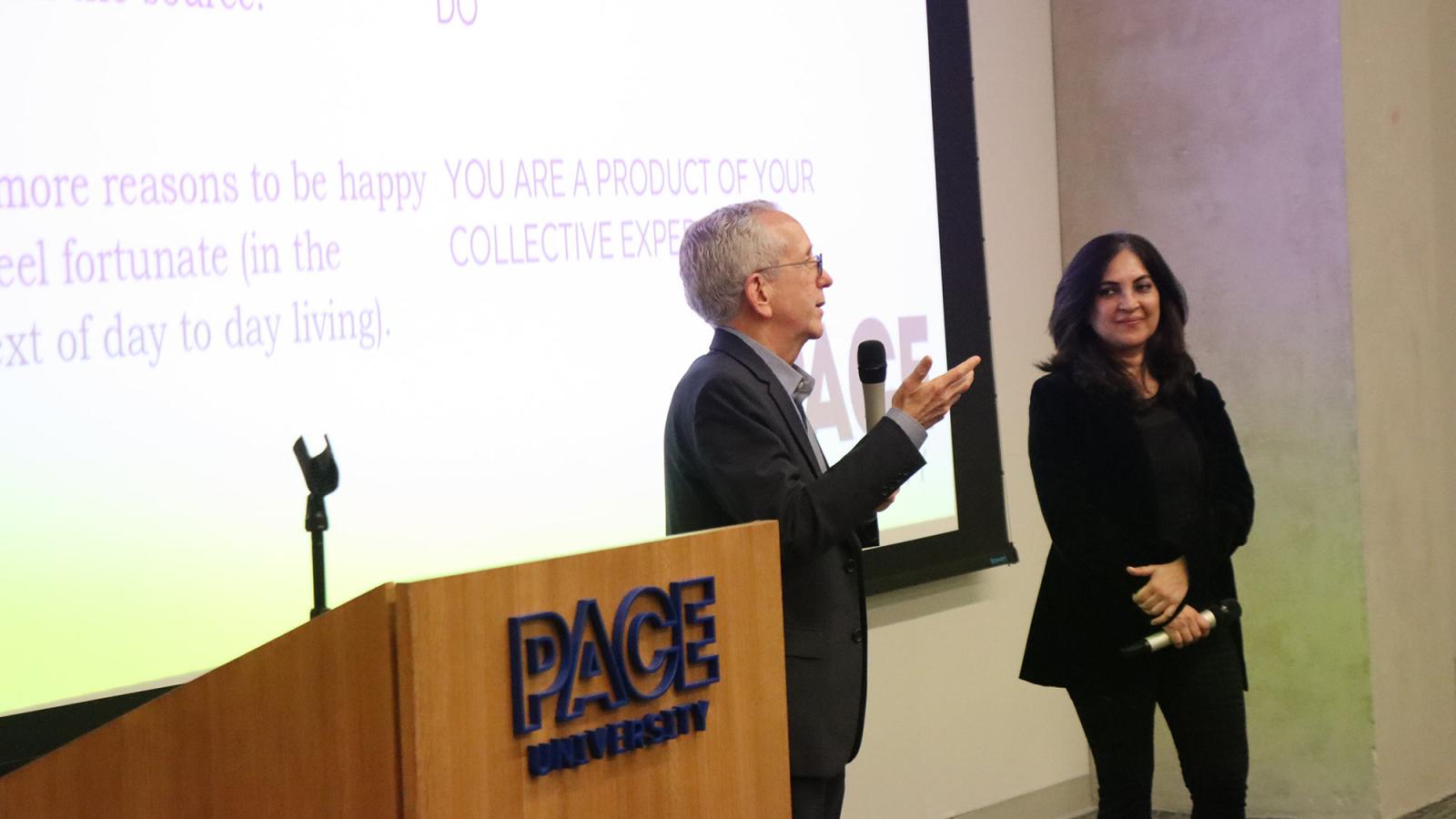
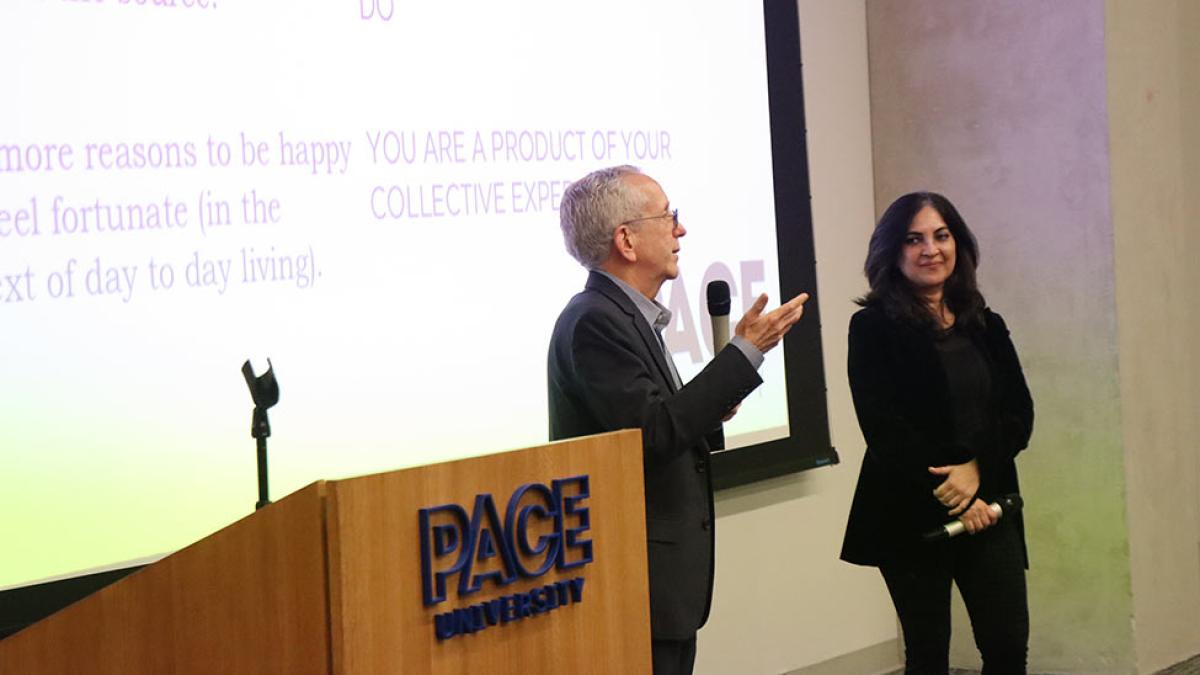
Keynote CEO Thomas Quinlan: Trust & Empathy Matter in Leadership
New Center developed in collaboration with Harvard’s Dr. Arthur Brooks helps Pace students lead with purpose
Emotional intelligence and teamwork are non-negotiable skills for effective leadership and success, according to an executive who runs a global company focusing on marketing, communications, and creative services.
In speaking with a large group of students, alumni, and business leaders at Pace University's New York City campus earlier this week, R.R. Donnelley President and CEO Thomas Quinlan III ’85, a Pace alumnus, told attendees that in addition to technical know-how, trust, empathy, and self-awareness are defining characteristics of great leadership in today’s workplace.
“You can’t lead alone -- and you can’t lead without emotional intelligence,” Quinlan said during a keynote at the closing session of the inaugural Center for Leadership and Emotional Intelligence (EI), a new initiative from the Lubin School of Business. “What makes teams work is not just skill—it’s trust, empathy, and the way you show up. AI is transforming the world, but people still want to work with people who care. That is what lasts.”
The six-week fall pilot brought together students, alumni, and faculty for a research-based leadership experience grounded in emotional intelligence. Participants earned digital credentials and engaged with themes like resilience, empathy, and purpose-driven growth.
“This program changed how I think about leadership,” said Muskan Kumari ’26, a graduate student majoring in Business Analytics from Karachi, Pakistan. “It gave me real tools to manage stress, lead with empathy, and grow with purpose. I walked away more confident—not just in my career path, but in who I want to be.”
Developed in collaboration with Dr. Arthur C. Brooks, bestselling author and professor at Harvard Kennedy School and Harvard Business School, the program draws on research from his book Build the Life You Want, coauthored by Brooks and Oprah Winfrey.
Ipshita Ray, associate professor of marketing, serves as the academic lead for the program. Inspired by her personal journey through stage three cancer, she created the Center to help students develop not just professional skills, but the emotional resilience to thrive.
“This program empowers our students with the mindset and tools to thrive—not just as leaders in their fields but as people committed to building lives of meaning and joy,” said Ray. “The support we’ve seen across Pace—from faculty, alumni, and students—proves how deeply needed and valued this kind of work is in higher education.”
Built on Brooks’ research and classroom work at Harvard, the curriculum helps students master the “micro-nutrients” of happiness—enjoyment, satisfaction, and purpose—while also introducing practical strategies for resilience, self-awareness, and emotional agility.
“This is a leadership movement grounded in emotional intelligence,” said Neil Braun, Lubin dean emeritus and former NBC television network president who helped lead the initiative. “Our students are learning how to lead by example—with compassion, clarity, and the ability to turn challenge into opportunity.”
Ajay Khorana, dean of Lubin School of Business, emphasized how the program prepares students to lead with empathy and adaptability in a rapidly evolving workforce.
“Even as the workplace transforms, emotional intelligence endures as a defining strength,” said Khorana. “Your capacity to lead, adapt, and build meaningful connections will set you apart.”
Pace University President Marvin Krislov also spoke about the program’s long-term impact on students’ personal and professional development.
"This program is more than curriculum—it’s a head start,” said Krislov. “Emotional intelligence is the skill that sets great leaders apart, and what students gained here will give them an edge when it matters most.”
Following the success of the pilot, the Center for Leadership and Emotional Intelligence (EI) will expand to Pace University’s Pleasantville campus in Spring 2026.
About the Lubin School of Business at Pace University
Globally recognized and prestigiously accredited, the Lubin School of Business integrates New York City’s business world into the experienced-based education of its students at Pace’s suburban and downtown campuses, implemented by one of the region’s largest co-op programs, team-based learning, and customized career guidance. Its programs are designed to launch success-oriented graduates toward upwardly mobile careers.
About Pace University
Since 1906, Pace University has been transforming the lives of its diverse students—academically, professionally, and socioeconomically. With campuses in New York City and Westchester County, Pace offers bachelor, master, and doctoral degree programs to 13,600 students in its College of Health Professions, Dyson College of Arts and Sciences, Elisabeth Haub School of Law, Lubin School of Business, Sands College of Performing Arts, School of Education, and Seidenberg School of Computer Science and Information Systems.
Pace University Deep Dives: Past Digital Issues
Missed a deep dive? Catch up with past issues here.


Deep Dives is an immersive, long-form digital publication exploring timely and complex topics that shape Pace University and the world around us. Each thematic issue brings together expert voices, research, and storytelling to illuminate the transformative work happening across our campuses.
Young Voters Powered Zohran Mamdani's Rise In NYC. Can Other Dems Energize Them In 2026?
Dyson Political Science Professor Laura Tamman remains an essential voice in coverage of New York City’s political landscape. In Lohud, she discusses how Mayor-Elect Zohran Mamdani galvanized young voters by translating policy proposals into direct, concrete messages that can overcome generational distrust in government.
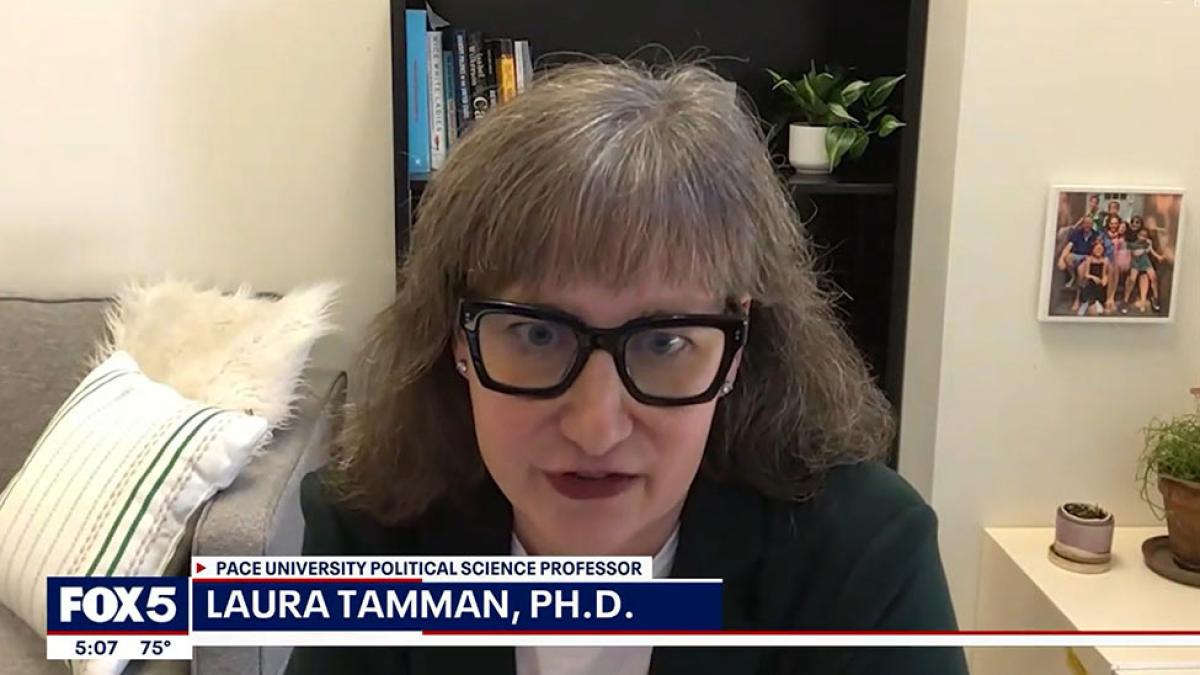
Bad Bunny Is The Latest Product Of Political Rage — How Pop Culture Became The Front Line Of American Politics
Dyson Communication and Media Studies Professor Adam Klein pens a widely circulated op-ed in The Conversation examining how today’s cultural icons, including global superstar Bad Bunny, have become vehicles for political expression and catalysts in broader ideological battles. He argues that the convergence of entertainment and political identity has turned artists into frontline actors in America’s intensifying culture wars.
Zohran Mamdani-Proofing: Eric Adams Moves To Cement Agenda — And Halt Successor's
In Newsday, Dyson Political Science Professor Laura Tamman questions whether Mayor Eric Adams can be trusted to do the right thing as his term winds down amid persistent allegations of corruption and self-dealing. She also joined NY1’s Inside City Hall with Errol Louis to analyze Mamdani’s early City Hall appointments and what they signal about his transition priorities.

Op-ed | Donald Trump’s uglification of America
In amNewYork, Pace Haub Law Professor Bennett Gershman pens a powerful op-ed examining how President Donald Trump’s towering monuments, incendiary rhetoric, and erosion of democratic norms signal a deeper moral and structural deterioration within American civic life. Professor Gershman writes that this sweeping “uglification” is reshaping the nation’s public landscape and unsettling the democratic foundations that once held firm.
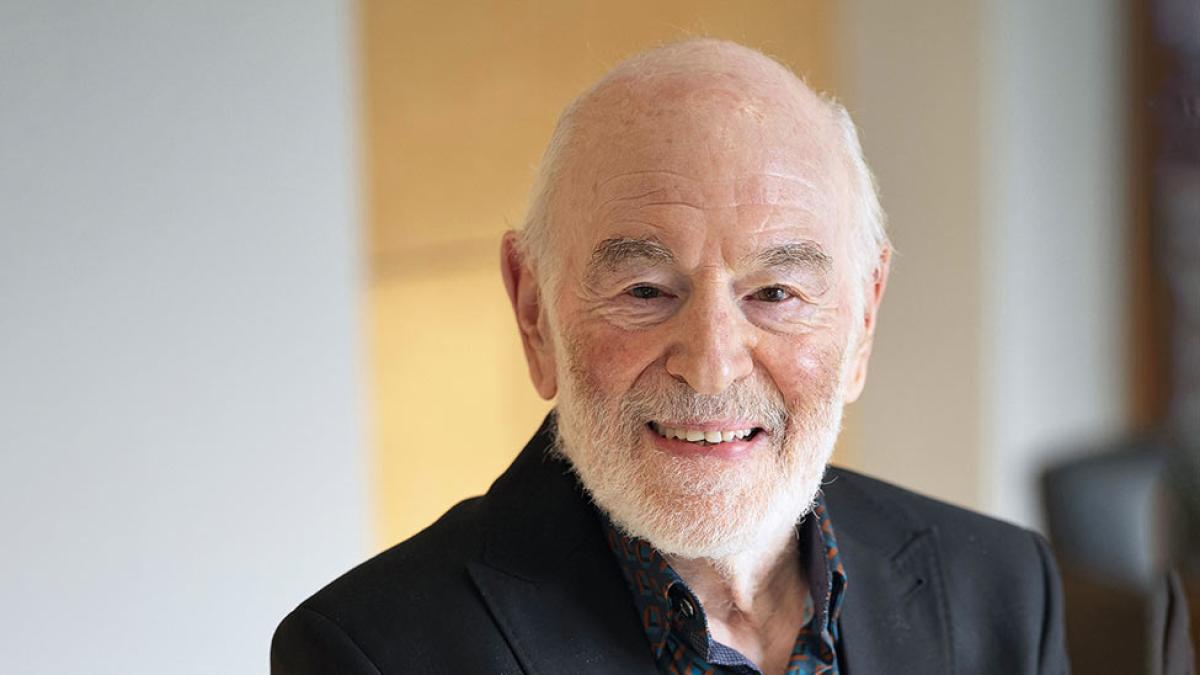
Financial Strain Deepens for America’s Seniors
Dyson Economics Professor Veronika Dolar speaks to PIX11 News about the escalating financial crisis facing seniors, noting that nearly half of Americans nearing retirement have no savings at all. She explains that soaring health-care and long-term-care costs are forcing older adults into untenable choices—especially those with chronic medical conditions—and warns that without meaningful policy action, the nation faces a severe retirement security crisis.
Bringing the Bench Behind Bars: Plan Would Require Yearly Prison Visits by Judges
Pace Haub Law Professor Emeritus Michael Mushlin was featured in THE CITY regarding a landmark proposal that would require New York judges who make sentencing or detention decisions to conduct meaningful annual visits to prisons and jails across the state. As chair of the subcommittee that developed the proposal, Professor Mushlin has helped lead the effort to ensure that judges better understand the realities of incarceration and the consequences of their decisions from the bench. If adopted, the rule would make New York the first state in the nation to mandate such visits.
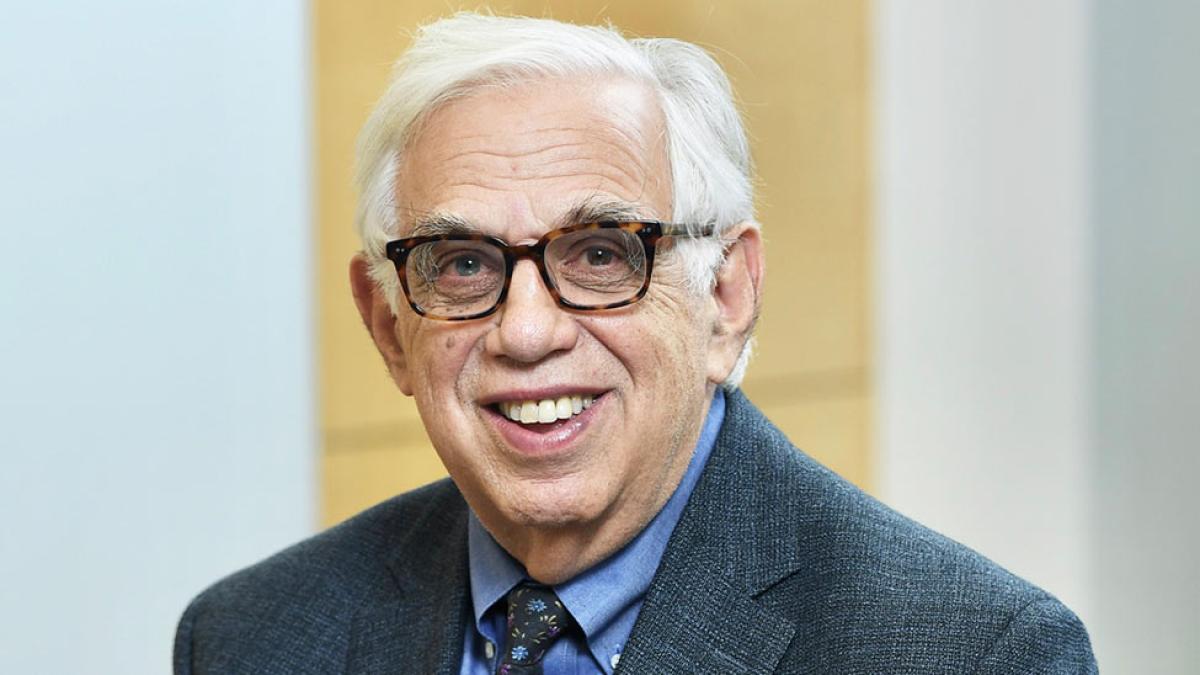
Mamdani's Election
Dyson Communication and Media Studies Professor Seong Jae Min writes a piece in The Korea Times about the political implications of Mayor-Elect Mamdani’s victory, examining how shifting ideological currents—particularly among younger voters—signal deeper changes in New York City’s political alignment.
